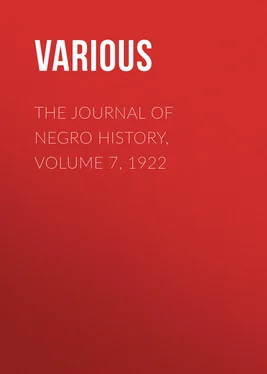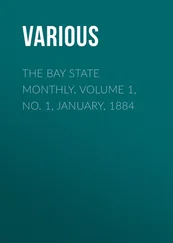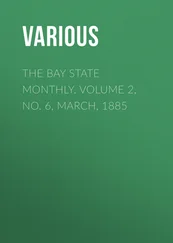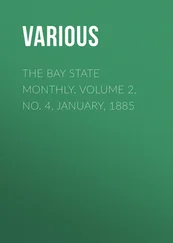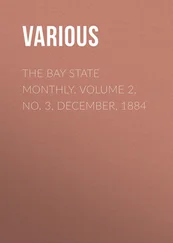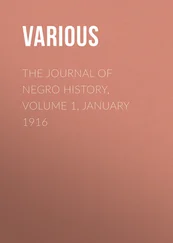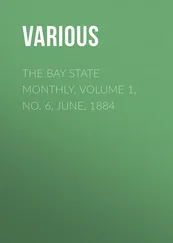Various - The Journal of Negro History, Volume 7, 1922
Здесь есть возможность читать онлайн «Various - The Journal of Negro History, Volume 7, 1922» — ознакомительный отрывок электронной книги совершенно бесплатно, а после прочтения отрывка купить полную версию. В некоторых случаях можно слушать аудио, скачать через торрент в формате fb2 и присутствует краткое содержание. Жанр: foreign_antique, periodic, История, foreign_edu, на английском языке. Описание произведения, (предисловие) а так же отзывы посетителей доступны на портале библиотеки ЛибКат.
- Название:The Journal of Negro History, Volume 7, 1922
- Автор:
- Жанр:
- Год:неизвестен
- ISBN:нет данных
- Рейтинг книги:3 / 5. Голосов: 1
-
Избранное:Добавить в избранное
- Отзывы:
-
Ваша оценка:
- 60
- 1
- 2
- 3
- 4
- 5
The Journal of Negro History, Volume 7, 1922: краткое содержание, описание и аннотация
Предлагаем к чтению аннотацию, описание, краткое содержание или предисловие (зависит от того, что написал сам автор книги «The Journal of Negro History, Volume 7, 1922»). Если вы не нашли необходимую информацию о книге — напишите в комментариях, мы постараемся отыскать её.
The Journal of Negro History, Volume 7, 1922 — читать онлайн ознакомительный отрывок
Ниже представлен текст книги, разбитый по страницам. Система сохранения места последней прочитанной страницы, позволяет с удобством читать онлайн бесплатно книгу «The Journal of Negro History, Volume 7, 1922», без необходимости каждый раз заново искать на чём Вы остановились. Поставьте закладку, и сможете в любой момент перейти на страницу, на которой закончили чтение.
Интервал:
Закладка:
The Strivings in Southern West Virginia
In southern West Virginia there were at first few schools for Negroes, inasmuch as the small Negro groups here and there did not warrant the outlay. What instruction such Negroes received prior to 1888 was largely private. That year an epoch was marked in the development of the southern portion of the State by the completion of the main line of the Norfolk and Western Railroad, opening up one of the largest coal fields in the United States. As the discontented Negroes of Virginia and North Carolina were eager for industrial opportunities in the mining regions of the Appalachian Mountains, these coal fields attracted them in large numbers. Bluefield, which developed in a few years from a barren field in 1888 to a town of almost ten thousand by 1900, indicates how rapidly the population there increased. Other large centers of industry, like Elkhorn, Northfork, Welch, and Keystone, soon became more than ordinary mining towns.
When these places had worn off the rough edges of frontier settlement and directed their attention to economic and social welfare, they naturally clamored for education. The first school for whites was established in Bluefield in 1889 and one for the Negroes, with Gordon Madson as teacher, followed in 1890. Prominent among the pioneering teachers in Bluefield were Mr. A. J. Smith and Mrs. L. O. McGhee, who began their work in a one-room log building in the suburbs of the town. About the end of the nineties there were Negro schools in most of the important mining towns along the Norfolk and Western Railroad between Bluefield and Williamson.
The Negro school in Bluefield had an interesting history. The school, of course, was poorly equipped and the teachers were not then adequately paid, but they continued their work two sessions of five months each. In the third year the school was moved to another town called Cooperstown where it was housed in a two-room building more comfortable than the first structure, but not a modern establishment. As it was situated in crowded quarters, the children had no playground. Several years thereafter, the work was continued by Mr. Patterson and Mrs. E. O. Smith. When, however, a large Negro population settled in North Bluefield it was necessary to provide there a two-room building between them. In this school-house taught Mr. P. J. Carter with an enrolment of about thirty pupils. Not long thereafter the building in the suburb of Cooperstown was burned. Two additional rooms were then annexed to that of North Bluefield, but before that could be occupied it was also destroyed in the same way. The Board of Education then opened a school, in a building used first as a bar-room, then as a pool-room, and finally as a courthouse. Thereafter an old store-room was used for four years.
There were then four teachers in Bluefield, Mr. H. Smith, Mr. T. P. Wright, Mesdames Lane, and E. C. Smith. In time Mr. Wright and Mr. Smith were replaced by Miss H. W. Booze, Mr. W. A. Saunders and Mr. R. A. McDonald. Mr. Saunders remained for one year and then was followed by Mr. G. W. Hatter who was in his turn succeeded by Mr. R. F. Douglass, who served as principal four years. Mr. Douglass had the board of education appropriate funds for a six-room building and increase the corps of teachers to five. By raising funds in the community through entertainments and the like, the teachers purchased a library of 100 volumes. In later years Mr. Douglass was followed by Mr. E. L. Rand, a graduate of Lincoln University.
At Keystone in 1890 Mr. J. A. Brown opened its first Negro school with an enrolment of about twenty-five. He was a man of fair education, but could not accomplish very much because the term was only three months in length. The school was held in one of the private houses belonging to the coal company and later in the church. In subsequent years there was very much development in the right direction, which proved the quality of the teachers employed in the school. Among these were Rev. J. Whittico, Mrs. Josephine D. Cannady, Mary A. McSwain, and Maggie Anderson. This school was later combined to form the Keystone-Eckman graded school, and now has an eight months' term and well-qualified teachers. 52A school had been established at Eckman in 1893 by James Knox Smith.
In November, 1892, one Moses Sanders at Northfork opened a school with an enrolment of twenty. He had only a rudimentary education. He served at Northfork for three terms using methods considered fair for that time, and his work, as a whole, was regarded as successful. He had there the support of such a useful person as Henry Glenn, now a member of the board of education. 53This school has later developed into a standard elementary graded school and a junior and senior high school of more than one hundred students. It has done well under the reorganization and direction of the efficient J. W. Robinson.
Higher Education of Negroes
It did not require much argument to show that the schools could not make much progress without some provision for developing its own teaching force. The State Superintendent was early authorized, therefore, to arrange with some school in the State for the professional training of Negro teachers. For a number of years the State depended largely upon such normal training as could be given at Storer College at Harper's Ferry. The reports of the State Superintendent of Schools carried honorable mention from period to period of the successful work being accomplished there under the direction of Dr. N. C. Brackett, which work was the only effort for secondary education for Negroes in the State at that time. This was given an impetus by a measure introduced in the legislature by Judge James H. Ferguson of Charleston, providing for an arrangement with Storer College by which eighteen persons as candidates for teachers in this State should be given free tuition at that institution. As this school was in the extreme northeastern section of the State and was geographically a part of Maryland and Virginia, however, the Negroes of the central and southern portions of Virginia soon began the movement for the establishment of a Negro school providing for normal instruction nearer home. Mr. William Davis and his corps of teachers in Charleston, West Virginia, were among the first in West Virginia to direct attention to this crying need. Impetus was also given the movement by the rapid development of higher grades in Point Pleasant, Saint Albans, Montgomery, Lewisburg and Eckman, necessitating better trained teachers. In the summers of 1890, 1891, and 1892, Byrd Prillerman and H. B. Rice undertook to supply this need by conducting a summer school in the city of Charleston. Still further stimulus came later from the establishment of promising high schools in Parkersburg, Wheeling, Clarksburg, Huntington, and Charleston.
During this same period, however, a systematic effort was being made to interest a larger group in the more efficient training of Negro leaders. The Baptists of the State, led by C. H. Payne, undertook to establish a college in West Virginia. Payne toured the State in behalf of the enterprise, setting forth the urgent need for such an institution and showing how this objective could be attained. Rallying to this call, the people of the State raised a sum adequate to purchase a site, which was soon sought by authority of the Baptists of the State. They selected the abandoned building and grounds of Shelton College, overlooking Saint Albans. Because of race prejudice, however, the people of that town started such a protest that the owners of the property were induced not to sell the site for such an unpopular purpose.
A more successful effort, however, was soon made. Talking with Superintendent Morgan about the necessity for higher education for the Negroes of West Virginia, Byrd Prillerman obtained from this official the promise to support a movement to supply this need. Superintendent Morgan furthermore directed Prillerman to Governor Fleming to take up with him the same proposal. The Governor was in a receptive mood and informed Prillerman, moreover, that this problem could be more easily solved than he had at first thought, for the reason that such an institution could be so established as to benefit by the Morrill Land Grant Act intended to subsidize, with funds from the proceeds of public lands, institutions largely devoted to instruction in Agriculture. Like the Negro Baptists of the State, Governor Fleming thought of purchasing Shelton College in St. Albans; but inasmuch as that place was not available the State government had to take more serious action. As Governor Fleming said he would give his approval to a bill for the establishment of such an institution, the only problem to be then solved was to find persons to pilot such a measure through the legislature. Superintendent Morgan outlined the plans for this legislation. He showed how necessary it was to secure the support of Mr. C. C. Watts and Judge James H. Ferguson. Byrd Prillerman used his influence in securing the support of Mr. Watts and C. H. Payne induced Judge Ferguson to lend the cause a helping hand. These gentlemen framed the measure which, after some unnecessary debate and unsuccessful opposition from friends of Storer College, they piloted through the legislature in 1891 as a measure establishing the West Virginia Colored Institute.
Читать дальшеИнтервал:
Закладка:
Похожие книги на «The Journal of Negro History, Volume 7, 1922»
Представляем Вашему вниманию похожие книги на «The Journal of Negro History, Volume 7, 1922» списком для выбора. Мы отобрали схожую по названию и смыслу литературу в надежде предоставить читателям больше вариантов отыскать новые, интересные, ещё непрочитанные произведения.
Обсуждение, отзывы о книге «The Journal of Negro History, Volume 7, 1922» и просто собственные мнения читателей. Оставьте ваши комментарии, напишите, что Вы думаете о произведении, его смысле или главных героях. Укажите что конкретно понравилось, а что нет, и почему Вы так считаете.
